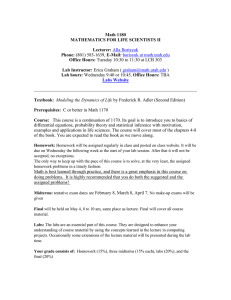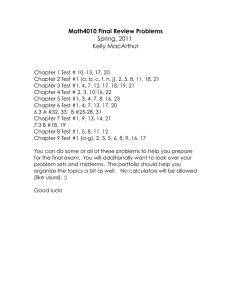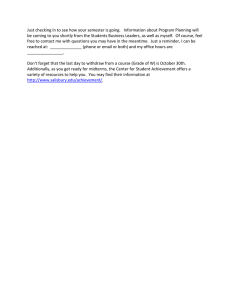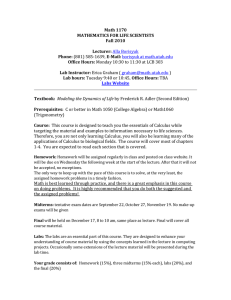PHYSICS 130, Sections 1911 and 1916 Lecture
advertisement
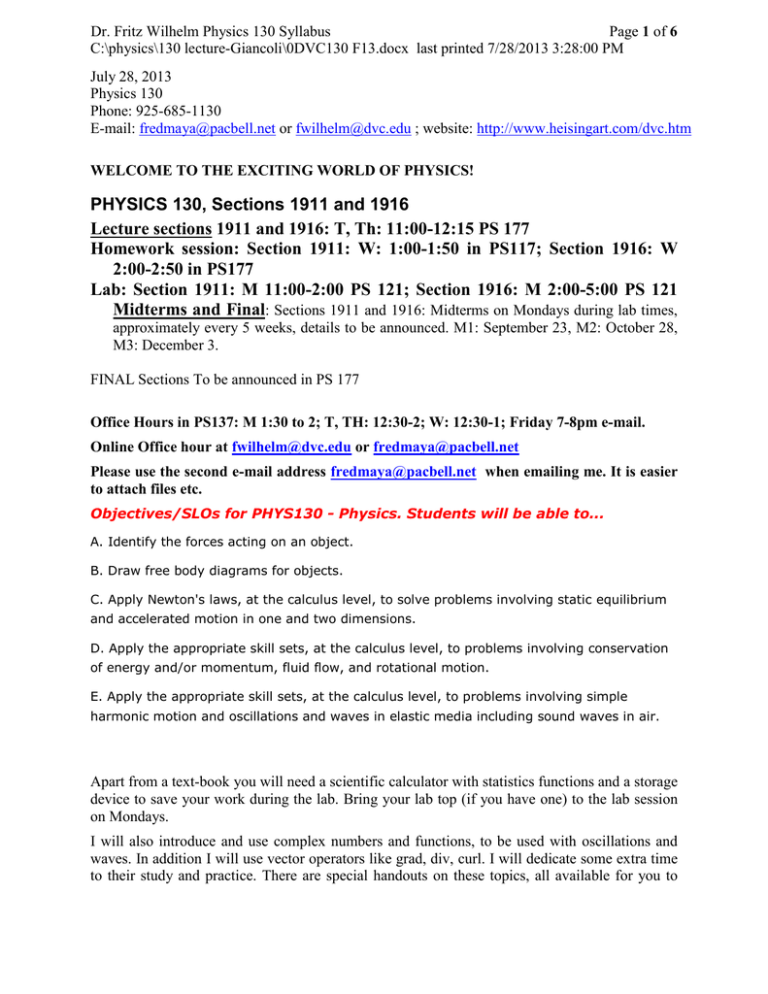
Dr. Fritz Wilhelm Physics 130 Syllabus Page 1 of 6 C:\physics\130 lecture-Giancoli\0DVC130 F13.docx last printed 7/28/2013 3:28:00 PM July 28, 2013 Physics 130 Phone: 925-685-1130 E-mail: fredmaya@pacbell.net or fwilhelm@dvc.edu ; website: http://www.heisingart.com/dvc.htm WELCOME TO THE EXCITING WORLD OF PHYSICS! PHYSICS 130, Sections 1911 and 1916 Lecture sections 1911 and 1916: T, Th: 11:00-12:15 PS 177 Homework session: Section 1911: W: 1:00-1:50 in PS117; Section 1916: W 2:00-2:50 in PS177 Lab: Section 1911: M 11:00-2:00 PS 121; Section 1916: M 2:00-5:00 PS 121 Midterms and Final: Sections 1911 and 1916: Midterms on Mondays during lab times, approximately every 5 weeks, details to be announced. M1: September 23, M2: October 28, M3: December 3. FINAL Sections To be announced in PS 177 Office Hours in PS137: M 1:30 to 2; T, TH: 12:30-2; W: 12:30-1; Friday 7-8pm e-mail. Online Office hour at fwilhelm@dvc.edu or fredmaya@pacbell.net Please use the second e-mail address fredmaya@pacbell.net when emailing me. It is easier to attach files etc. Objectives/SLOs for PHYS130 - Physics. Students will be able to... A. Identify the forces acting on an object. B. Draw free body diagrams for objects. C. Apply Newton's laws, at the calculus level, to solve problems involving static equilibrium and accelerated motion in one and two dimensions. D. Apply the appropriate skill sets, at the calculus level, to problems involving conservation of energy and/or momentum, fluid flow, and rotational motion. E. Apply the appropriate skill sets, at the calculus level, to problems involving simple harmonic motion and oscillations and waves in elastic media including sound waves in air. Apart from a text-book you will need a scientific calculator with statistics functions and a storage device to save your work during the lab. Bring your lab top (if you have one) to the lab session on Mondays. I will also introduce and use complex numbers and functions, to be used with oscillations and waves. In addition I will use vector operators like grad, div, curl. I will dedicate some extra time to their study and practice. There are special handouts on these topics, all available for you to Dr. Fritz Wilhelm Physics 130 Syllabus Page 2 of 6 C:\physics\130 lecture-Giancoli\0DVC130 F13.docx last printed 7/28/2013 3:28:00 PM download from my website. (Whenever I use the term "website" I am talking about my own website, not the DVC website.) Recommended books are Mathematical Methods in the Physical Sciences, by Mary L. Boas, and Handbook of Mathematics by Bronshtein-Semendyayev. The best lectures on Physics (apart from my own) are Feynman’s Physics Lectures. Check them out on Amazon or other websites. On my website www.heisingart.com you will also find paintings of my wife and wildlife photography by me: eagles, hawks, beavers, river otters, animals and landscapes from our very area around here. Don’t forget nature over the study of physics. Nature in its unpredictability is the ultimate reality. If, during and outside of the lectures, you want me to explain something in physics or mathematics, ask! The complete set of homework problems is posted on the website, download them one by one in the order I teach them and solve them as much as you can. I will tell you in time which file to download. The official book of the class is Volume 1, Physics for Scientists and Engineers by Douglas Giancoli: Physics for scientists and engineers, 4th edition. The books by Serway 6th and 7th edition are the books which the college has been using during previous years. (Note that there are some differences in the chapter numbers between the books by Giancoli and Serway. Giancoli covers Gravitation in chapter 6, Fluid Mechanics in chapter 13, Serway covers Gravity in chapter 13, fluid mechanics in chapter 14.) You can get the Serway books used at our bookstore or on the Internet for much better prices. I cover chapters 1 through 16 in the book of Giancoli, but not sequentially. You need to keep good notes. Here is the general plan: The first midterm will cover chapters 1-5, 7, 8 in the text by Giancoli. The second midterm covers 9, 10, 11, 6. The third midterm covers 12, 13, 14. The final will be comprehensive with 5 problems from chapters 15 and 16. This plan is subject to changes. You also need Microsoft Word, and Excel. Also, you need Mathtype from http://www.Dessci.com Mathtype is much easier to use than Equation Editor which is built into Microsoft Word. Download it and install it on your computer. It will become a part of Word. I announce in class when there is a new file for you on the website to download and study. For our first discussion session you need to download and print handouts “ch 0 Uncertainty Calculations.pdf”, and ch 01 homework.pdf and ch 01 introductory formulas. When you hand in a lab report, midterm, or final, always write your last NAME first, then your middle and first name (do things in the way you register). Write your whole name legibly in CAPITAL LETTERS. This is important, because I do not want to have cases with mistaken identities. As mentioned, I have posted lecture notes and homework problems on the website. I expect you to do the homework problems and come with questions to the homework sessions (Wednesday). Download the additional lecture notes from my website. Problems I solve in class should get your special attention, as many of them reappear in midterms. During our discussion sessions I will discuss homework problems of the latest two chapters on which I lecture. During our very first homework session I lecture on uncertainty calculations and a few other things. Website address: Dr. Fritz Wilhelm Physics 130 Syllabus Page 3 of 6 C:\physics\130 lecture-Giancoli\0DVC130 F13.docx last printed 7/28/2013 3:28:00 PM http://www.heisingart.com/dvc.htm I want to help you as much as possible. By the way, I am not only a physicist but also a philosopher and poet, as you will soon discover. My particular interest in physics is quantum mechanics and its relationship with thinking. I mention this to you to show that contrary to common beliefs, art and science can and should go very well together. If you have any interest in some of this maybe we have some common ground to share. I have written a book called "Dancing with Maya" which shows how quantum physics limits all knowledge in a very fundamental way, thus leaving open the possibility of creative and intelligent thinking as can be found in some poetry, mythology, and religions. If you are interested in this you can download a copy of "Dancing With Maya" from my website. I received my bachelor degree at the Sorbonne (Paris), and my Master’s as well as my Ph.D. at the University of Karlsruhe in West Germany. Attendance, Participation, and Official Record I expect you to attend every class, lab, and work-session, and to catch up on any classes missed by getting lecture notes from classmates (not from me!). Turn off your cell phones etc. Do not take notes with your lab top during classes. The attention to your computer distracts you and you miss to actually comprehend what I teach. The same holds for taking notes in the lab. NOTE: The worst thing you could possibly do to yourself is to miss a class. If you must be absent, it is not necessary to call or explain. But if you miss three or more classes, your standing in the class may be endangered, and you should discuss your progress with me. I expect you to take notes during class and to work at home with these notes. Consult a dictionary and use the spell checker in Word! Make sure you understand everything in them, and, if necessary, make appropriate corrections. Ask me as to the pronunciation of words. Start a vocabulary book with foreign expressions and definitions. If you don’t understand something in the lecture or in the book, let me know it, so that everyone can benefit from my explanations. Problems I solve in class have a tendency to show up in midterms. I am interested in what you think and feel about physics, mathematics, my lecture, your educational process, and so forth. Let us talk! In that way we shall have a lot of fun together. The responsibility for keeping your enrollment status straight with the college and with me rests on you. Note that you are not enrolled in the class until you have received a computer printout with this class printed on it. This is particularly important if you add the class late. CLASS WORK The class consists of 3 hours in lectures (two 75 minute sessions), work-sessions (1 hour), and lab-work (3 hours), 1 hour =50 minutes. Read every chapter and corresponding lecture notes before and after the lecture. Annotate your book with remarks using a color pen and or color markers. Dr. Fritz Wilhelm Physics 130 Syllabus Page 4 of 6 C:\physics\130 lecture-Giancoli\0DVC130 F13.docx last printed 7/28/2013 3:28:00 PM Taking good notes is a skill you must develop as early as possible. I know that it is difficult to listen and to take notes at the same time. This is where your preparation comes in. Don’t take notes of everything I say, but it is a good rule to copy at least all I write on the board. Slow me down, or at least you may try to. I know the required speed in order to cover the material. I WANT TO HELP YOU! ASK QUESTIONS. I do not grade your homework. Do make a serious effort to solve the homework problems and use them as a study tool. Seeing me solve them does not work for you. We will solve most of them together in the discussion sessions. Again, some of these problems will show up in the midterms. If you don’t attend the discussion sessions you are setting yourself up for failure in the class. The same holds for not attending the lectures, in which I teach some material which is not contained in the text-book. It is part of the lecture notes of course. LAB reports of Lab N must be handed in before the beginning of Lab N+1. We will be able to have about 9 labs total. For every day you turn in your lab too late I will subtract one point out of ten; i.e. after ten days you get a zero on your lab. You must complete the labs with at least a C (62%) in order to receive a passing grade (C). If you are not present during more than 2 lab sessions without a valid reason (as determined by me) and without catching up during the makeup sessions (see below) you will not get a passing grade in the class. Talk with me before it is too late, if you have problems! There will be two makeup lab sessions, in which you can make up one lab you have missed due to sickness, or improve the grade of two labs up to 8.5 (B) points. You can improve (not totally redo) two of the preceding labs per make-up session. If you fail to attend a lab without convincing me with a valid reason for your absence, you cannot redo this lab. You will get 0 points for it. You must hand in your lab-report at the beginning of the next lab session, even if you have not completed it. You can only make up a lab if you have handed in a previous version. This must be attached to the back of your make up lab. Otherwise you get a 0 for it. You cannot make up lab 1, 2, 3, 4 during the second makeup session. Theoretical labs cannot be made up at all unless I give permission, because I have no way of checking whether you copied them from another student after my corrections. In other words, you can improve four labs altogether up to 8.5 points, if your lab reports are otherwise deemed perfect by me. Two makeups in the first makeup session, another two in the second makeup session. Copying a lab from someone else is cheating and will have serious consequences and will earn you at least 10 negative points. When labs contain homework problems, those will be worth 2 points out of 10, and they cannot be made up. These two points are automatically deducted from your lab grade if you hand the lab in late. In other words, if a lab contains homework problems and you hand them in late, the maximum points you can get is 6. Any made up lab must have your notes and the previously graded lab stapled to the back. When I correct your lab reports I also give negative points for grossly negligent stuff, like, for example having results with totally wrong dimensions, or having results which are contradicting what you just wrote. These negative points cannot be made up. I will keep track of them in a separate column, but in the end they will be added to your lab grade. Here is the good news, I also give extra credit points for outstanding work or extra challenges, which I announce, for example an error margin below 0.5%. Careful and diligent work will be rewarded. Dr. Fritz Wilhelm Physics 130 Syllabus Page 5 of 6 C:\physics\130 lecture-Giancoli\0DVC130 F13.docx last printed 7/28/2013 3:28:00 PM I give three midterms at 100 points each. There will be a comprehensive final for 200 points. I have the following Grading Policy: The labs (L) and each of three midterms (M1, M2, M3) count for 100 points; the final (F) counts for 200 points; I drop the worst of the first two midterm grades (called “Min”), in case that is of advantage to your final grade. I also reward outstanding participation in the class with extra points (at my discretion)! On a 100 scale your class grade will be determined by this formula: M=the best of the two possibilities M1+M2+M3-Min or 2/3(M1+M2+M3); F = final. a) if L>80, (M+L+F)/5; or b) (M+2L+F)/6 if F>119.5; or c) if F>100, (3M+F/2+L)/8; or d) (M/2+3F+L/2)/7.5 if L>75.0 and (M+F)>240; e) [2(M1+M2+M3) +L+F/2]/8 if F>100; f) if L>80 then F/2 is your final number of points. I use the best of all the choices. As you can see, in formula d) the final accounts for 80% of the grade; in f) it counts for 100% but only if your lab average is better than 80.0. If your labs are very good they also influence the grade heavily (up to 33%), but only if your final is at least 120/200 points. If your midterms are very good I will count them as 2/3 of the grade in c). For those who take all three midterms with good results, formula e) might be of advantage. I’ll share the Excel formulas with you during our first meeting. You can download the examples from my website. The file is called Do not let your lab reports slip. The last day to hand in made up labs and have them counted will be the day of the last regularly scheduled class before the finals week. A = 90.0 points or more, B = 77.0 to 89.0 points, C = 62.0 to 76.0 points, D = 48.0 to 61.0 points, F = 0 to 47.0 points. I will not grant special opportunities to make up a grade or a lab outside of the rules laid out here for everyone. There will be no exceptions. Specifically, don’t send me e-mails explaining how hard you worked and how much you need a C, or B, to maintain your GPA or to get into a specific college. Your grade is in your hands for a whole semester. I expect you to work hard. I will not respond to any such e-mails. After the first midterm, feel free to discuss your progress individually with me. It is relatively easy to get a C, it is much more difficult to get a B or even an A grade. Remember that you must not only have decent grades but that above all you must have a comprehension of the material presented. I test for comprehension, not for plug-in skills. Comprehension is of utmost importance if you want to succeed later at a four year college. If you have questions during the class, ask immediately. It is much more fun to work together! If you work hard, you will be successful and enjoy the class. Don’t wait with your studies until the day before the midterms, it will be too late. Work regularly and do the assigned homework problems as much and as well as possible. PHYSICS 130 LAB PRESENTATIONS You need Microsoft Word and Excel for your lab work. Do not take notes with your lab-top but write on paper. Attach these notes always to the printed version of your notes. All mathematical formulas must be written with the “MS Word” equation editor or better yet with the program Mathtype which I introduce to you during our first lab session. Bring your lab top to the first lab-class (next Monday) if you have one. Visit the website DESSCI.com and get a trial version to use for one month. If you like it, I urge you to purchase a copy. It is very helpful. Dr. Fritz Wilhelm Physics 130 Syllabus Page 6 of 6 C:\physics\130 lecture-Giancoli\0DVC130 F13.docx last printed 7/28/2013 3:28:00 PM Here are some rules to follow for the lab presentations: Most important for your reports is a clean, logical, and comprehensive presentation of your lab work. Use the following approach: Divide your presentation into three major parts: A. Purpose and theory. This is all written by me on the blackboard. 1. Describe and derive the major formulas to be used and verified in the lab. Show the derivation of formulas as shown in the lab by me. Everything I write on the board during the beginning of the lab must be on your write-up in Word. Use EXCEL for graphs and statistics, whenever possible. The computers in the computer room have all necessary programs installed. Learn how to move schedules and graphs from Excel into Word. Use equation editor (Mathtype) in Word for your formulas. Include pictures of your lab setup. Do not make photocopies, or other copies, of each other’s work. This is cheating and will result in 10 negative lab-points for the student who copied and the student who allowed the copy. Keep your dated and signed by me lab notes and raw data to the back of your report. It is proof that you have done the lab. You must be ready to show me these notes. Otherwise, I must assume that you copied it from someone. 2. Description of the experiment, as shown by me with your added comments. Use drawings, either by hand or with Word, or through photos. B. Organize your results in easily readable tables with explanatory headlines. Include error calculations or estimated errors as percentages and absolute errors. A most important part of all our labs is the calculation of relative and absolute errors. Knowing these will determine the correct number of significant figures in your results. C. Concluding remarks, only if meaningful. Every report must have your name, the name and number of the lab, your class and section, the date, as well as the names of your partners. Write your report using a word-processor like Word. (Use proper English with proper spelling and grammar. I deduct points for mistakes, bad presentations, and sloppiness!) A template of the lab report is on the website. Put all material used during the lab back to its appropriate place. Note that the labs are very important for your grade. GOOD LUCK AND SUCCESS TO YOU ALL There will be pdf files on many chapters on the web, covering topics in class in the way I teach them. Download them and study them, together with your notes. http://www.heisingart.com/dvc.htm

